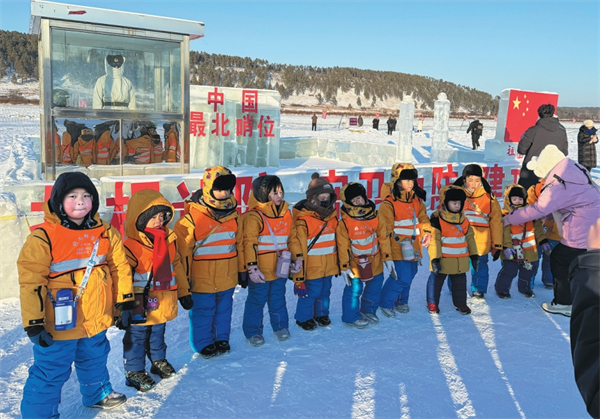Home>Harbin Today
Harbin: Strong trade hub
Updated : 2015-09-28
By Tian Xuefei and Zhou Huiying ( China Daily )

Above: Harbin Pingnan Thermal Power Plant at the South Harbin Industrial City. [Photo by Fan Dawei/China Daily] Below: Workers at an electric business logistics center at the South Harbin Industrial City, which is the country's first e-commerce border warehouse to Russia. [Photo provided to China Daily]

Over the past two years, as the center of the Heilongjiang economic belt, the capital city of Harbin has been actively involved in the construction of the Heilongjiang Land and Maritime Silk Road Economic Belt, part of the Belt and Road Initiative proposed by President Xi Jinping in 2013.
"At present, Harbin has achieved a better situation in economic development, which can help lay a good foundation for the construction of the Belt and Road Initiative," said Zhang Lixin, head of the publicity department of the Harbin city Party committee.
Daowai district
In past decades, despite being the district with the longest history in the city, Daowai district missed out on many development opportunities. Then, in 2013, the district's fortunes turned when the city government decided to develop its modern logistics industry there.
Taking advantage of its key location in the East Harbin Modern Logistics Industry Belt, Daowai district constructed an industrial park focused on a state-level small towns pilot project, trade with Russia and a modern logistics cluster.
With the completion of many key projects, including the Huanan City Shopping and Business Complex, Transfar Intelligent Highway Port and Zhongshun Automobile Park, Daowai district has become instrumental in leading the province's modern logistics industry development.
Daowai Industrial Park, with an area of 32.25 square kilometers, attracted 48 investment-promotion projects with a total investment of 9.2 billion yuan ($1.44 billion) in 2014.
"Daowai district is expected to become the core area for Northeast Asia international logistics developments and the demonstration area for a new type of urbanization," said an official of the district. "We also have the confidence to build it into an important passageway for the Silk Road Economic Belt."
South Harbin Industrial City
Construction of South Harbin Industrial City, an important part of the Harbin Economic and Technological Development Zone, began in 2010.
After years of development, it has become the zone's heart, gathering talent, logistics, information and capital under the Belt and Road Initiative.
It has convenient transportation with five railway lines connecting to the Russian Far East and six state-level highways. In the future, Subway Line 1 will extend there.
It covers a total area of more than 460 square kilometers, including a 75 sq km core development area.
More than 8,000 companies, including 28 Fortune Global 500 companies, have moved to the area since it was built in 2010, covering fields such as new materials, electronic information and robots.
It achieved a total industrial output of more than 200 billion yuan and a main business income more than 300 billion yuan.
It is now home to 300 large-scale industrial enterprises, achieving more than half of the city's total industrial output. Its listed companies now account for 66 percent of the city's total and 50 percent of the province's total, which has made the area the engine for rapid economic development in the province.
Daowai district and South Harbin Industrial City are two examples of success in the construction of the Heilongjiang Land and Maritime Silk Road Economic Belt under the nation's strategy of the Belt and Road Initiative.
Located in the center of Northeast Asia, Harbin has its own advantages in working with Russia.
At the same time, it has a strong industrial base, strong prospects for agriculture and advanced technological capabilities, which can help the city become a platform for economic cooperation with Russia, a logistics hub, a manufacturing base and an exchange center for financial information services, technology and culture.
"In the first half of 2015, the total import and export with Russia reached 135 million yuan, an increase of 10.1 percent," said Zhang Lixin, "The Ha'ou freight train had been put into service and the provincial government had applied to build the Harbin comprehensive bonded area."
In the first half of 2015, Harbin achieved GDP growth of 6.9 percent, while fixed-asset investment increased 7.1 percent.
"All the citizens have great confidence in the future development," Zhang said.

Harbin ramps up childcare services
A new comprehensive service center for childcare in Harbin is expected to be finished by the end of the year.
-
Talent policies drive enterprise development in Harbin
Harbin's "30 New Talent Policies" represents an iterative upgrade to the talent policy system, helping attract and retain talent to bolster economic and social development.
-
Official website of 2025 Asian Winter Games goes live
Harbin, the host city of the 9th Asian Winter Games, has announced that the official website for the 2025 event has recently gone live.
-
Harbin launches measures to facilitate more foreign trade
In the first three quarters of 2023, the total import and export value of Heilongjiang province's goods trade hit 218.22 billion yuan.





